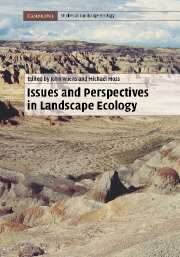Book contents
- Frontmatter
- Contents
- List of contributors
- Preface
- PART I Introductory perspectives
- PART II Theory, experiments, and models in landscape ecology
- PART III Landscape patterns
- PART IV Landscape dynamics on multiple scales
- PART V Applications of landscape ecology
- PART VI Cultural perspectives and landscape planning
- 26 The nature of lowland rivers: a search for river identity
- 27 Using cultural knowledge to make new landscape patterns
- 28 The critical divide: landscape policy and its implementation
- 29 Landscape ecology: principles of cognition and the political–economic dimension
- 30 Integration of landscape ecology and landscape architecture: an evolutionary and reciprocal process
- 31 Landscape ecology in land-use planning
- PART VII Retrospect and prospect
- Index
- Plate section
- References
29 - Landscape ecology: principles of cognition and the political–economic dimension
from PART VI - Cultural perspectives and landscape planning
Published online by Cambridge University Press: 20 November 2009
- Frontmatter
- Contents
- List of contributors
- Preface
- PART I Introductory perspectives
- PART II Theory, experiments, and models in landscape ecology
- PART III Landscape patterns
- PART IV Landscape dynamics on multiple scales
- PART V Applications of landscape ecology
- PART VI Cultural perspectives and landscape planning
- 26 The nature of lowland rivers: a search for river identity
- 27 Using cultural knowledge to make new landscape patterns
- 28 The critical divide: landscape policy and its implementation
- 29 Landscape ecology: principles of cognition and the political–economic dimension
- 30 Integration of landscape ecology and landscape architecture: an evolutionary and reciprocal process
- 31 Landscape ecology in land-use planning
- PART VII Retrospect and prospect
- Index
- Plate section
- References
Summary
It is the view of scientists, and of the public in general, that landscape ecology is a science of landscapes and humans. Landscape is a part of the earth's surface – a region perceived by humans (Hartshorne, 1939; Zonneveld, 1988). However, humans are also inhabitants and users of the landscape. Landscape is their immediate home but it is also a territory of broader political and economic interest. It is the space where humans live, travel, work, and rest. This relationship between humans and the landscape has acquired a special meaning, especially in relation to negative phenomena, even conflicts, which have originated as responses to human activities.
Humans were never on the earth as impartial visitors but from earliest times perceived landscape as their environment. Consequently, environmental problems were those that called for a solution. Humans not only perceived landscape pattern as scenery but they also started to evaluate land-use arrangements by using economic and ecological principles. The impact of humans on the landscape resulting from their activities became the subject of public supervision, decision making, and planning. At the same time, tools useful in acquiring knowledge were activated and scientific research was oriented toward forecasting the consequences of land use and of understanding the potential, or the limits, of a conflict-free functioning of landscape. The theory and methodology of geography, landscape ecology, and also biology (especially geobotany) became the foundation for this reasoning and for the resolution of practical problems.
- Type
- Chapter
- Information
- Issues and Perspectives in Landscape Ecology , pp. 296 - 306Publisher: Cambridge University PressPrint publication year: 2005



